Choosing the Right Green Beans for Fermentation
- When making fermented green beans, they should be untrimmed and loose from the store or farmers’ market. DO NOT buy green beans that have been trimmed, triple-washed, and packaged in a plastic bag because they will not ferment well. It is possible to have success with the bagged type of green beans; however, it is more likely that the fermentation fails.
- Good options for sourcing quality green beans are your local farmers market, Whole Foods Market, sprouts market, and open-aired produce stands. Many grocery stores that have a fresh produce section with vegetables not packaged in plastic also carry fresh green beans.
- Make sure the green beans are crisp, hydrated, and fresh. It should quickly and easily snap if you try to bend one in half.
- Green bean season in the USA is late spring through early fall, so this will be the easiest time to find fresh green beans.

Equipment You Need to Make Fermented Green Beans


How to Make Fermented Green Beans
This recipe is simple! The hardest part is waiting two weeks for the fermentation process to finish. Why two weeks? Well, here’s what happens when green beans are fermented for two weeks at about 76° F:
24 – 72 hours: All contents in the jar should be submerged beneath the brine. At this time, Gram-negative bacteria, yeasts, fungi, and possible pathogens are still are still present.
72 hours – 7 days: After 72 hours, you should start to see lots of bubbles produced, and the green beans will begin to change color. This is the stage in which you will burp the jar. This is when the ferment enters stage two of vegetable fermentation. Leuconostoc bacteria begin to thrive and produce a lot of carbon dioxide. Gram negative organisms from stage one have all died off.
7 – 12 days: The bubbles in the brine will decrease as the ferment leaves stage two and enters stage three. The mixture will become cloudy and start to develop a pleasantly sour smell. Lactobacillus species are most abundant during this period.
12 – 14 days: Lactobacillus dominates the microbial population. They produce copious amounts of lactic acid, making the ferment smell even more pleasantly sour. This is the time in which the vegetable mixture becomes preserved. This is when you want to smell and taste test.
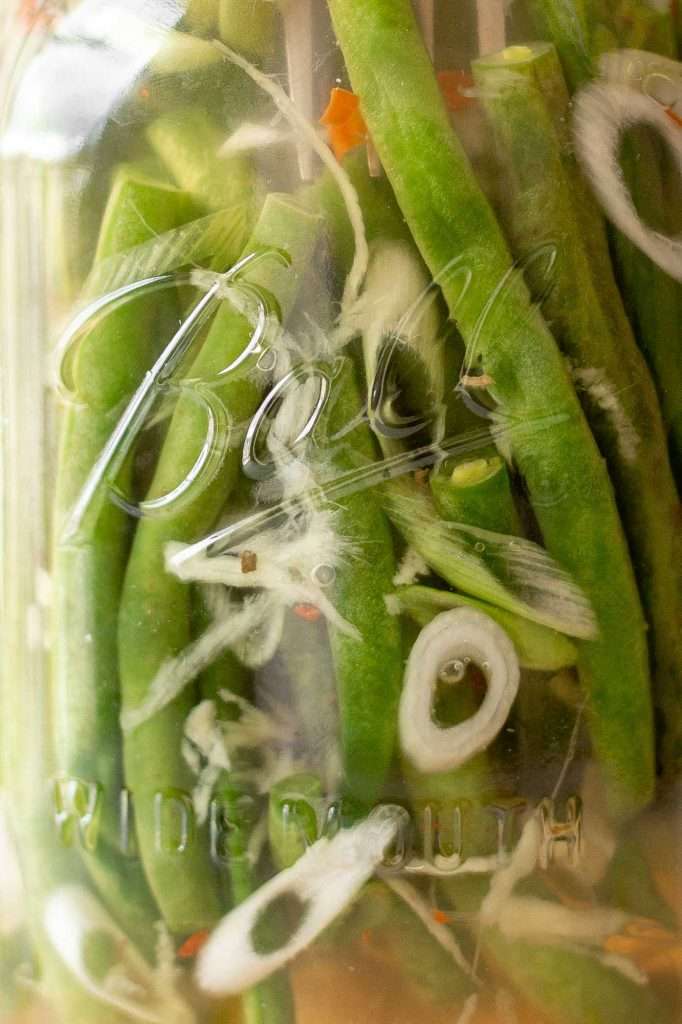
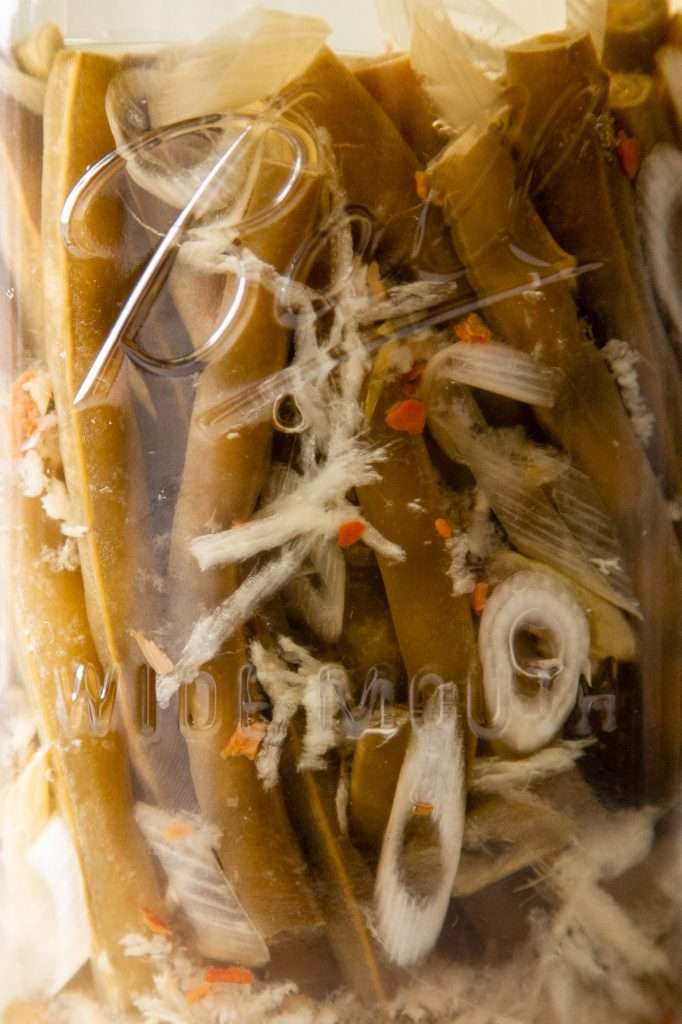
Can You Ferment Vegetables That Come in a Bag?
No, you cannot ferment clipped, triple-washed green beans packaged in a plastic bag.
I do not recommend using triple-washed, pre-chopped vegetables in a plastic bag for fermentation. These vegetables are usually triple-washed, with “vegetable wash” and drying agents, which contain antimicrobial chemicals, sulfates, and phosphates—yes, even if they’re organic.
FDA food laws don’t require the packaging to tell you this because the “wash” is considered a food-contact substance, not a final product ingredient. These washing and drying agents kill most of the friendly microbes on the vegetables, so the microorganisms that facilitate a healthy fermentation process are not present.


Fermented Green Beans Benefits
Have you ever heard of GABA? It stands for Gamma-aminobutyric acid. It is a naturally occurring, non-protein amino acid that works as a neurotransmitter in your brain. GABA is studied and produced for its multitude of benefits:
- relieving anxiety
- improving mood
- inhibition of cancer cell proliferation
- reducing symptoms of premenstrual syndrome (PMS)
- aiding in attention deficit-hyperactivity disorder (ADHD) treatment
- lean muscle growth
- stabilizing blood pressure
- relieving muscle pain
Well, it turns out that the microorganisms involved in the lactic acid fermentation of vegetables produce a lot of GABA! This is especially true in fermented cucumbers and fermented green beans.
Biologically synthesized GABA, like that produced during fermentation, is more usable by the human body than chemically synthesized GABA. So if you need a mental wellness boost, try eating some fermented green beans.
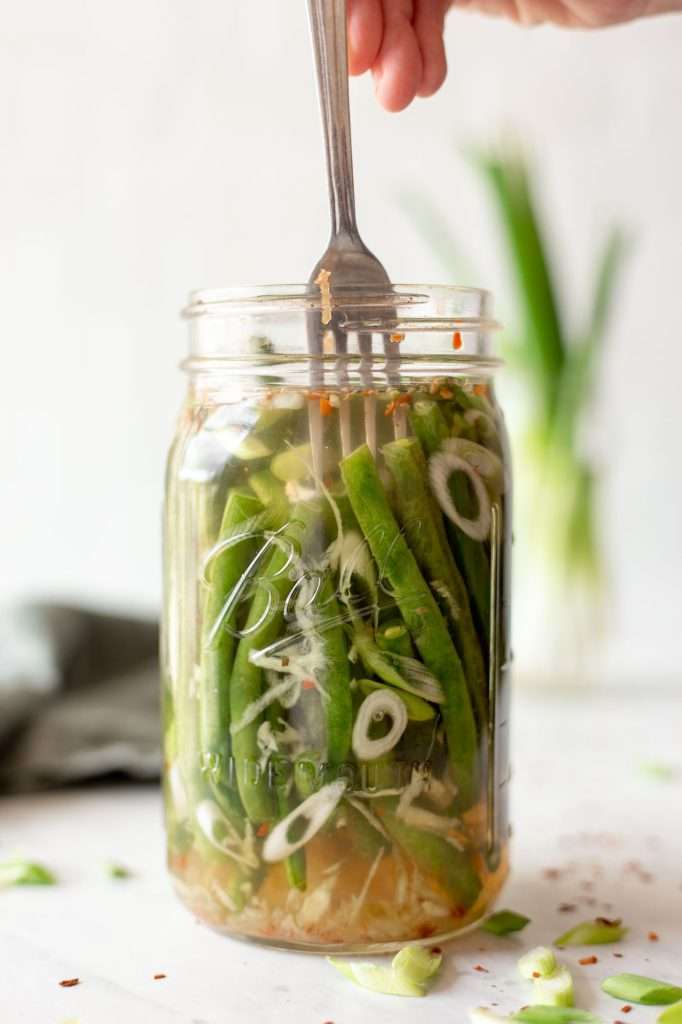
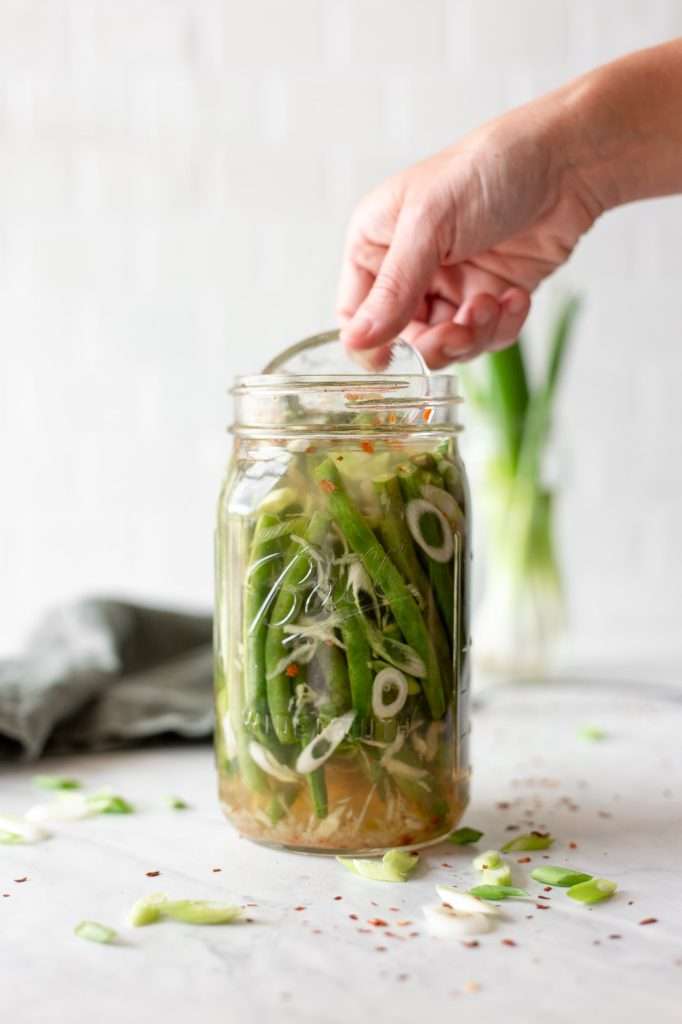
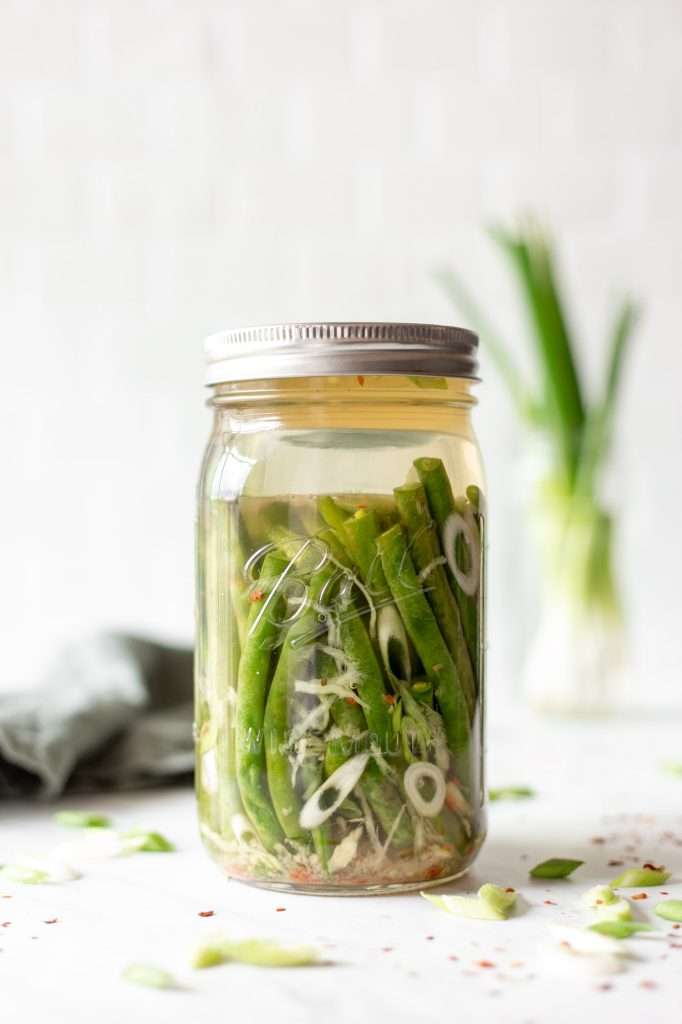

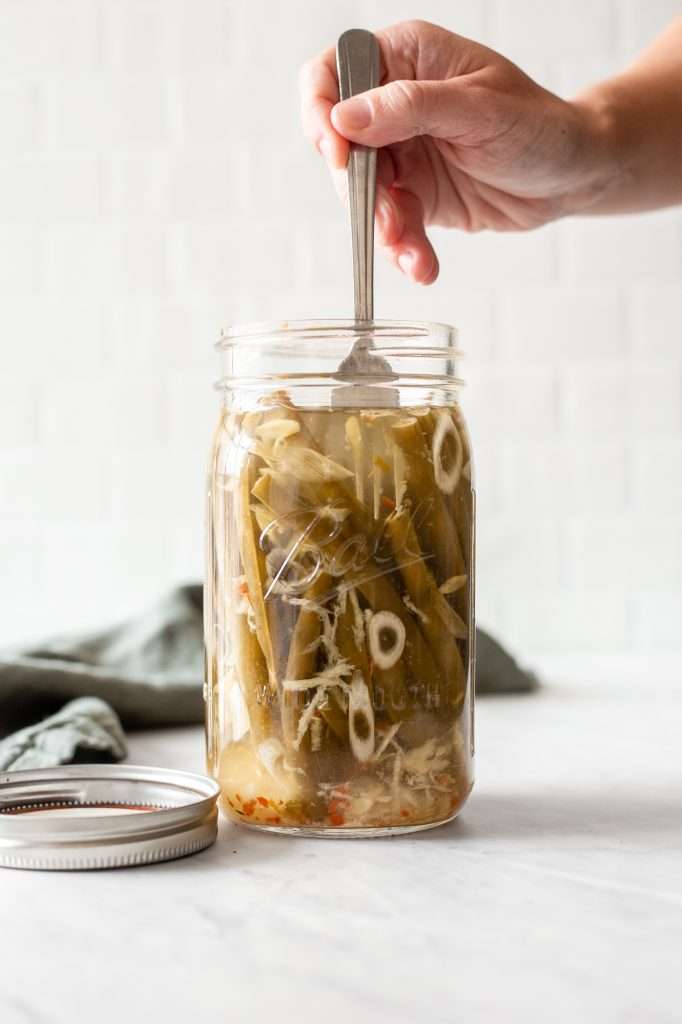
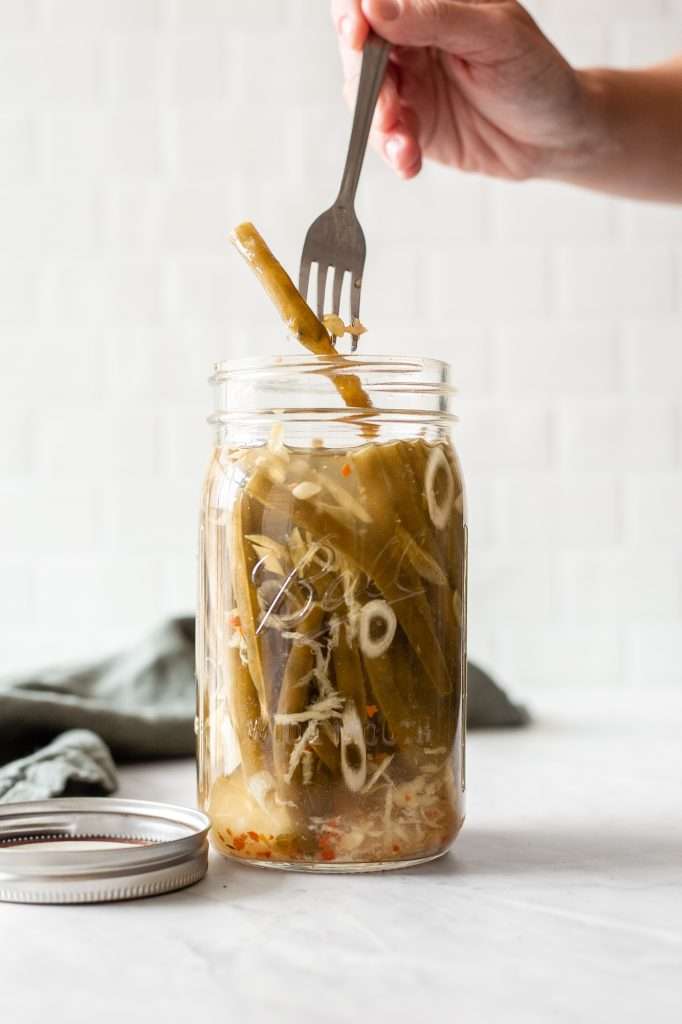
The Difference Between Pickled and Fermented Green Beans
Pickling and fermenting are very different processes. Pickling is a sterile process for preserving food, which means there are no microorganisms involved. This process utilizes hot acidic liquid and hermetically sealing to sterilize and preserve vegetables.
Fermentation is a living process that relies on acid production by beneficial microorganisms. It takes time and requires a specific salt concentration for consistency and safety. So fermentation encourages microbial growth, and then the microbes make acids that preserve the foods. To read more about salt and fermentation, click here.
Print
The Best Fermented Green Beans with Ginger and Scallions
You can make these probiotic-packed fermented green beans at home with just salt, water, fresh green beans, and spices. Fermenting green beans requires a kitchen scale for measuring ingredients and two weeks of fermentation at room temperature.
- Prep: 10 minutes
- Total Time: 336 hours 10 minutes
Ingredients
- 325 grams fresh green beans
- 425 grams water
- 10 grams grated ginger root
- 30 grams scallions, chopped
- A pinch of red pepper flakes
- 32 grams sea salt
Instructions
- See recipe notes please!
- Cut the ends off the green beans and rinse them well in cool water.
- Measure your salt and water. Dissolve the salt in the water.
- Add the green beans, ginger, and scallions to the 1-quart mason jar, and fill the jar with the water and salt mixture.
- Place your fermentation weight in the jar and make sure the weight and all the green beans are submerged in the salt brine.
- Place the mason jar lid on the jar and secure it closed.
- Allow for fermentation at room temperature for 2 weeks.
- During the first three days, expect a lot of carbon dioxide production. You will need to gently open the jar lid to let some of the gas out daily. At the one week mark, you should notice the bubbles decreasing and eventually stopping completely at two weeks.
- Check the pH at two weeks to ensure it is below four. Once it is, store the fermented green beans in the fridge.
Notes
- This recipe requires a higher salt concentration to prevent the growth of kahm yeast. Green beans are high in the FODMAPs sorbitol and mannitol that can encourage yeast growth. A 4% to 5% salt concentration usually controls this.
- This recipe is sized to fit a 32-ounce mason jar at 1x.
- Do not use triple-washed green beans. Triple-washed, bagged vegetables do not have the microbes necessary to initiate fermentation.
- I suggest using a wide-mouth mason jar.
- It’s best to set the fermentation jar in a glass baking dish to catch any liquid that seeps out while it’s bubbling.
- The green beans will keep in the fridge for a year or two.




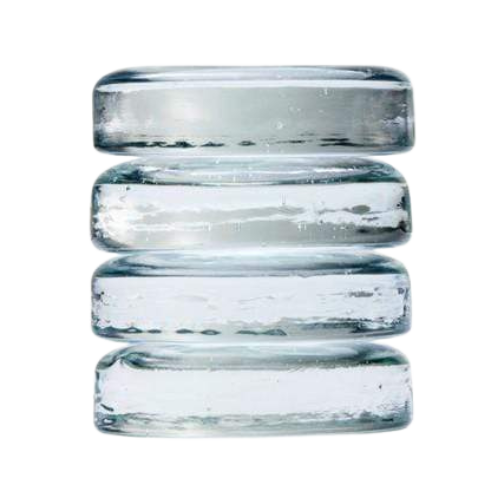
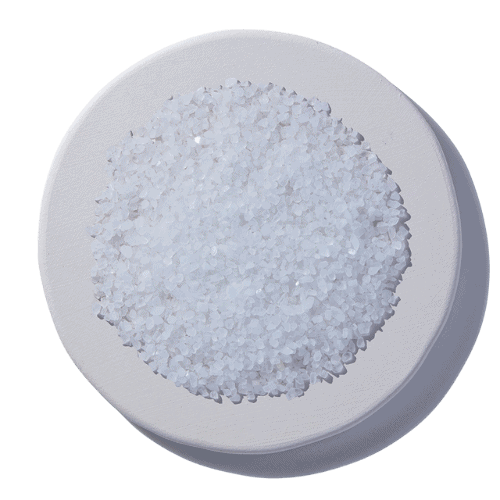
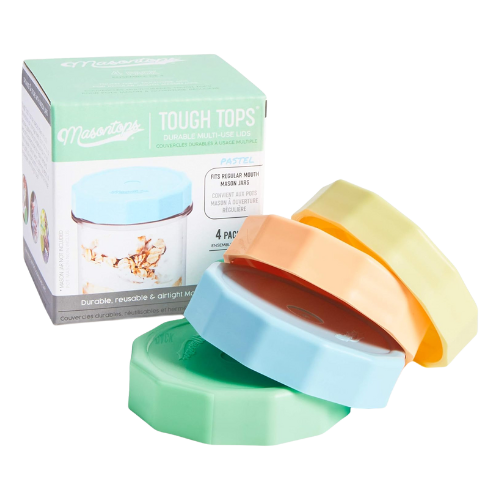













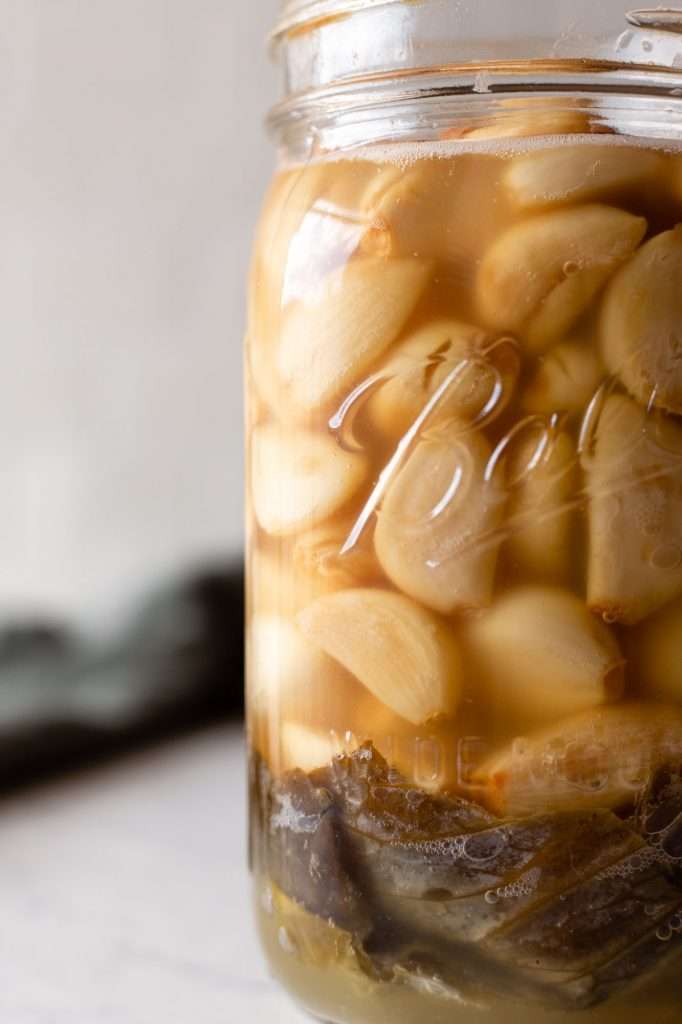
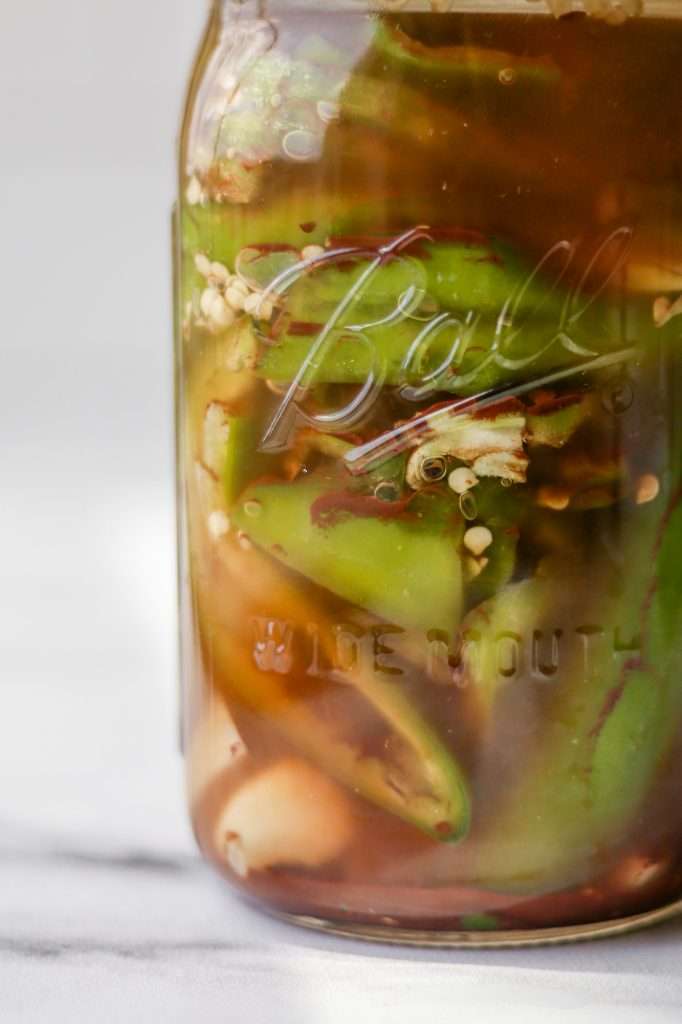




Hello Kaitlynn,
we have tried the bean recipe and it is delicious. But a few hours after eating them I had stomach cramps and violent diarrrhea. Now I have read that you should never eat raw green beans and that you should also cook fermented green beans before eating in order to deactivate the protein phasin in the beans which is poisonous. Why do you not mention that and what are your experiences with this? My husband also had beans – and no symptoms.
Hi there,
There’s an insignificant, negligible amount of lectin proteins in green beans. Fermented green beans are even better because the beneficial bacteria digest and reduce lectin content by over 95%. Sounds like you personally need to cook them? I cooked some fermented green beans in a curry last night and they were great.
You should ask your primary care physician or another medical professional about any personal food intolerance symptoms you experience.
I, my husband, and my whole family eat them straight out of the jar all the time with no issues.
Note: After a quick search of peer-reviewed papers, I can find no clear evidence that raw green beans have PHA levels high enough to make them unsafe. The level of PHA is highest in bean seeds. Green beans are eaten for the green fleshy pod, at a stage when the seeds are only beginning to develop.
Hey Kaitlynn,
thanks for your answer. We also thought that the fermentation process would take care of the lectins and – as I said: my husband did not have the same reaction to them. We live in Germany and the german sites all warn about the lectins and recommend cooking – hence my question. I appreciate that you took the time to give us that information.
happy fermenting!
Hi Kaitlynn, regarding cooking the fermented green beans, would that not destroy all the probiotics, and therefore the main benefits of fermenting them in the first place? One might as well freeze then cook them, which is a lot less hassle.
On the other hand, if someone were still worried about the negligible amount of lectin left over after fermenting, would it be possible to cook the beans before fermenting them? (I mean a light blanch for a minute or two in boiling water.) Or is it not possible to ferment the beans after cooking them? Be interested to know your views on that. Thanks.
I cook ferments all the time. I also eat them raw. I love putting my fermented green beans in this Dutch Oven Chicken Pot Pie with Sourdough Biscuits
I like the flavor of fermented vegetables in cooking, and find it worthwhile, not a hassle. You can totally blanch first then ferment. Just throw a couple cabbage leaves in with the beans to ensure there are wild microbes to initiate fermentation.
Good day Ma’am,
Pesticide residue is an ongoing concern for commercially produced vegetables here in the Philippines, and beans (snap, long) are specially problematic. Government agencies/personnel suggest pre-soaking in water with add-ons ranging from salt, vinegar, baking soda or combinations. Do you think it is effective? How would it affect the micro organisms? Do you have an alternative method?
Thank you.
If you would like to use conventionally grown vegetables that may contain pesticide residue, you can soak them and clean them as recommended. This may eliminate a lot of the microbes needed for the fermentation process. However, you can ensure good microbes are present and that fermentation still happens effectively by using a starter culture, or by adding some chopped inner leaves of cabbage to the bottom of the jar.
Ms Kaitlynn,
Thank you very much for your reply. Information you give out gives me the confidence to continue on my fermentation journey. Again, thank you.
First, thank you for keeping you recipes in grams! As anyone who has reviewed the Morton’s website knows, all Tablespoons of salt are not created equal. This is my second year dabbling in fermentation. I have probably read a couple hundred recipes and made about half a dozen. All the recipes I read prior to yours have recommended a salinity between 2% and 5% for Green beans, most at the lower end of that range around 3%; so, I am curious why you are recommending a salinity of 5.82% for Green Beans?
Using grams and a scale is the best.
Seems like the recipes you’ve read prior do not account for the water inside the vegetables.
I use total salt concentration in my recipes because it is more consistent and yields better sensory qualities for everyone who tries the recipe. This recipe uses about a 3.5% total salt concentration.
Total salt concentration logically factors in the weight of the green beans, because 90% of the weight of a green bean IS water.
For instance, if you top 1000 grams of green beans with 1000 grams of 3% salinity salt water brine, the beans will absorb salt from the added salt water brine until the salt concentration inside of the bean matches the salt concentration in the water outside of the bean. So the brine will end up being about 1.7% salinity inside and outside of the green beans… Which is too low and often leads to soggy, disgusting fermented beans.
If you calculate the % of salt to add with the weight of the water AND vegetables factored in, then you can determine the total salt concentration that will from inside and outside the vegetable. 3.5% total salt concentration is best for things that grow from blossoms (cucumbers, beans, peppers etc) to stay crunchy.
I hadn’t thought about it that way before, but it makes sense. I appreciate you sharing your knowledge and insights. Can you recommend any references that document the percent of water in various vegetables? In addition to Green Beans, I am very interested in understanding: Asparagus, Okra, Radishes, Hot Peppers, and Cucumbers. Just based on bite and mouth feel, I would have thought that Cucumbers have the highest percent of water by weight, green beans would have much less water by weight, with Pepper some where in between. It appears that I am incorrect?
Pretty much all vegetables are 90-98% water, so not a big margin of difference between vegetables. Cucumbers are about 98% water, green beans are 90%, and peppers are 92-95%. I don’t have a chart I use or anything. For simplicity, I essentially treat the vegetables like they are 100% water in my recipes.
If I didn’t get any bubbles.. what did I do wrong?! And is it still safe to eat? I didn’t have enough green beans to follow the exact measurement but I still did the right percentage of salt.
You probably didn’t do anything wrong. How long has it been since you started them and what kind of lid/jar are you using? Jars with loose lids, like the weck jars without the gasket or a mason jar with a loose lid wont allow the bubbles to build up so you wont see them.
Super excited to taste the beans I started 2 weeks ago! Quick question for you, though. My pH did not get below 4, I’m guessing because my house is cooler (~69F) than yours at 76F. In this case, am I still okay to eat them safely? Do I need to give them a few more days before sticking the jar in the fridge? Thanks!
what is the pH? anything below 4.6 is safe. My recipes all end up below 4 usually.
Testing with the paper strips, it’s tough to tell between 4 and 5, but it could be closer to 4 than 5? Maybe give it another couple of days then go to the fridge?
These are INSANELY GOOD. I have made with both fresh from the farmers market and store bought green beans (where I threw in a cabbage leaf for safe measure). I snack on them all day, even the little kids in my boyfriend’s family ate them at the last picnic. So good!
Can I make these with yellow or purple beans? Thanks!
I think so! Though, I haven’t tried it. There may be a big color change with purple beans, but that’s normal with any purple vegetables.
love all of this stuff, big question for me is what do we do with the brine after? How can we repurpose this? I do drink pickle juice after a work out, its the best. However salty brine, OTHER than using it as a brine for brining chicken before you cook how else can we use this?
Salad dressing, slow cooking roast, mixed with a little honey and wine for braising meat, fermenting (heirloom culturing) carrots , stuff like that.
Last year I made your fermented cucumbers recipe, which was a revelation, having failed to get a decent result over the years by pickling. That have me the confidence to make more, but that was at the end of the season so I’ve had to wait for this year’s crop and I’ve made loads. With that confidence this year’s end of the season discovery was this green bean recipe. I’ve just tried them, and wish I’d had the courage to make a lot more. Next year more of our bean crop will be fermented. Thanks for making fermenting science accessible. The precision and explanations make it easy to be successful. I like your humility towards other cultures traditions. Your site is more inspiring and encouraging than the 3 books on fermenting I’ve been trying to learn from. Brilliant work.
wow! Thank you so much for the kind words David! I’m glad you are enjoying my blog and recipes.
Can we use ginger paste out of a tube? I don’t have any fresh. Thanks!
I have read that uncooked beans can cause gastrointestinal upset toxic. Does the fermentation process neutralize that risk?
I’ve never read about that as it pertains to green beans. Fermentation does make green beans easier to digest. Feel free to blanch them first and add in a cabbage leaf to initiate fermentation.
I started that the other day but I forgot to fill the airlock with water for the first two days. Will these still be ok? The liquid is very cloudy. Thank you
it should be fine. Fermented vegetables don’t require an airlock.